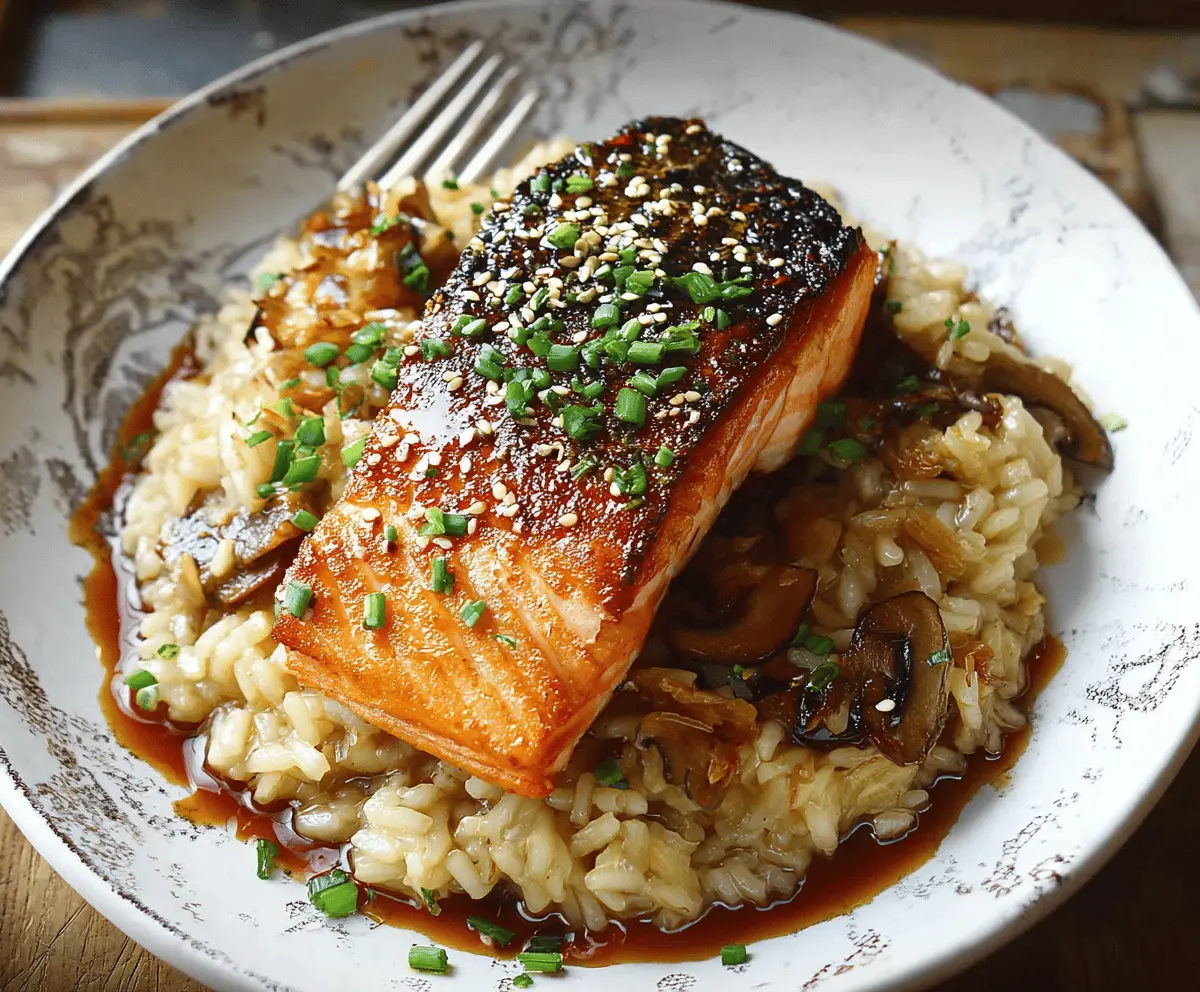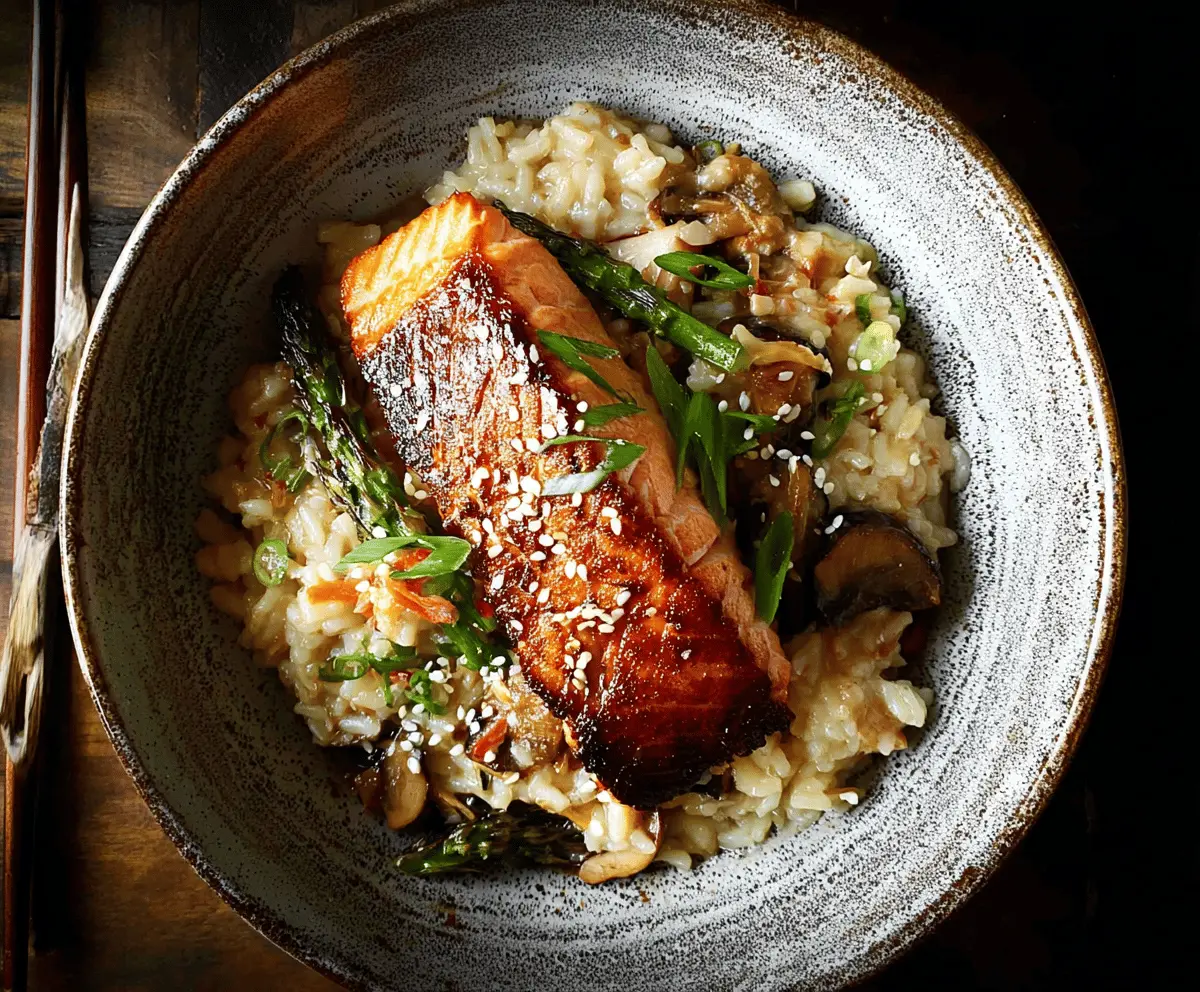This creamy Japanese style risotto pairs fluffy rice with tasty seared salmon. It’s like a warm hug on a plate, packed with umami flavors you’ll love!
When I make this dish, I can’t resist nibbling on the salmon while it’s cooking. It’s just too good! A sprinkle of green onions on top makes it extra special and pretty!
Key Ingredients & Substitutions
Japanese short-grain rice: This is essential for a creamy texture. Sushi rice also works well. If you’re in a pinch, you could use Arborio rice, but it won’t have the same flavor.
Dashi stock: This adds depth to the dish. If you can’t find dashi, use vegetable or chicken broth. For vegan options, check if your broth is plant-based.
Soy sauce: This gives the dish its umami kick. You can swap it with tamari for a gluten-free option or use coconut aminos for a sweeter flavor.
Mirin: This sweet rice wine balances the savory notes. If unavailable, use a mix of honey and water or a splash of rice vinegar mixed with sugar.
Mushrooms: Shiitake mushrooms are fantastic for this dish, but any fresh mushroom like button or cremini will do. Dried mushrooms are also a great substitute, just rehydrate them before use.
Salmon: I love using fresh salmon for its texture and taste. If you prefer a different protein, try seared tofu or grilled chicken for a lighter option.
How Do I Make Creamy Risotto?
Making the perfect risotto requires patience, but it’s worth it for that creamy texture. Here’s the trick: always use hot broth and stir frequently!
- Start by sautéing onions until they’re soft, then add the rice and coat it in butter—this step builds flavor.
- Once you add broth, let it absorb almost fully before adding more, stirring continuously. This helps release the starch for creaminess.
- Keep the heat at medium to avoid burning the rice while allowing the grains to cook evenly.
- After about 18-20 minutes, your risotto should be creamy and slightly al dente. Adjust seasoning to your taste.
Remember, risotto is all about your personal touch, so feel free to add your favorite veggies or herbs as you go!

Japanese Style Risotto With Seared Salmon
Ingredients You’ll Need:
For The Risotto:
- 1 cup Japanese short-grain rice (or sushi rice)
- 3 cups dashi stock (or substitute with vegetable or chicken broth)
- 2 tbsp soy sauce
- 1 tbsp mirin
- 1 tbsp sake (optional)
- 1 tbsp unsalted butter
- 1 small onion, finely chopped
- 1 cup shiitake mushrooms, sliced (or use other mushrooms)
- 8-10 asparagus spears, trimmed
For The Seared Salmon:
- 2 salmon fillets (about 5-6 oz each), skin on
- 1 tbsp vegetable or canola oil
For Topping:
- 2 green onions, thinly sliced
- 1 tsp toasted sesame seeds
- Salt and pepper to taste
How Much Time Will You Need?
This recipe takes about 30-35 minutes. You’ll spend around 10 minutes preparing the ingredients and cooking the vegetables, followed by about 20 minutes for the risotto to cook and the salmon to sear. It’s quick yet impressive!
Step-by-Step Instructions:
1. Prepare the Broth:
In a pot, warm the dashi stock (or your chosen broth) over low heat. It’s important to keep it hot so it can help the risotto cook evenly and quickly.
2. Sauté Vegetables:
In a large pan over medium heat, melt the butter. Add the chopped onion and cook, stirring occasionally, until it’s translucent, about 3-4 minutes. Next, toss in the sliced mushrooms and sauté until they’re nice and tender, which should take about 5 minutes.
3. Cook Asparagus:
Add the asparagus to the pan and sauté lightly for 2-3 minutes. You want them to be just tender but still crisp. Once done, remove the asparagus from the pan and set it aside to keep warm.
4. Start the Risotto:
Add the rice to the vegetable mixture in the pan, stirring to ensure each grain is coated in the buttery goodness. Cook for about 2 minutes while stirring.
5. Add Liquids Gradually:
Stir in the soy sauce, mirin, and sake if you’re using it. Then, gradually add a ladle of hot broth to the rice, stirring continuously. Wait until the liquid is mostly absorbed before adding more. Repeat this process, adding broth one ladle at a time, stirring often. Keep it going for about 18-20 minutes until the risotto is creamy and the rice is tender but still has a slight bite.
6. Season the Risotto:
Taste the risotto and adjust the seasoning with salt and pepper as needed.
7. Sear the Salmon:
While your risotto is cooking, pat the salmon fillets dry, and season both sides with salt and pepper. In a non-stick skillet, heat the vegetable oil over medium-high heat. Place the salmon skin-side down and sear for about 4-5 minutes until the skin is crisp and browned. Carefully flip the fillets and cook for another 2-3 minutes until the salmon is cooked through but remains moist inside. Remove it from the pan and let it rest.
8. Assemble the Dish:
To serve, plate the risotto on individual dishes and place a seared salmon fillet on top. Arrange the sautéed asparagus on the side or underneath the salmon.
9. Garnish:
Sprinkle the sliced green onions and toasted sesame seeds over the top for an added splash of color and a delightful nutty flavor.
10. Serve Immediately:
Your creamy, umami-rich Japanese style risotto with seared salmon is ready to enjoy! Serve hot and savor every delicious bite.
This dish merges the richness of risotto with Japanese flavors, highlighting the creamy texture from the rice, the savory umami from dashi, and the satisfying crunch of vegetables. Pair it with your favorite sake or a crispy white wine for a delightful meal experience!
Can I Use Different Types of Rice?
While Japanese short-grain rice is ideal for its creaminess, you can use Arborio rice as a substitute. However, the flavor and texture will be slightly different, so keep that in mind!
What Can I Substitute for Dashi Stock?
If you can’t find dashi, vegetable or chicken broth works well as a substitute. For a deeper umami flavor, you can add a splash of soy sauce to the broth.
Is It Possible to Make This Dish Vegetarian?
Absolutely! To make it vegetarian, simply omit the salmon and use vegetable broth instead of dashi. You can also add tofu or tempeh for protein!
How Should I Store Leftovers?
Store any leftover risotto in an airtight container in the fridge for up to 3 days. To reheat, add a splash of broth or water to restore creaminess as you warm it on the stove or in the microwave.



